2 or 3 row radiator?
#21
I had one of those.Paid about $150 three years ago.Been noticing a little anti freeze smell lately,so I pressure tested it.The core is leaking around the tubes.They are joined with EPOXY.This is a throwaway radiator.My radiator shop said we cant help you,and the lifetime warranty guy wont return my email.This is not a real all aluminum radiator.Real aluminum radiators have no epoxy to join the tanks to the core.Buy that turd at your own peril.I am replacing with copper brass.
#22
copied from another post I made awhile back:
there are alot of variables, some single core radiators can outperform a dual core radiator:
- depends on how wide each core is.
- 4 core doesn't pick up much efficiency over a 3 core since each successive core is being heated by the one in front of it, the same effect happens on a 3 core but to a lesser degree
- each core you add increases the resistance to airflow, actually, total thickness increases the resistance to airflow -> less airflow=less air to carry heat away
- "fin count" between the cores has a big effect on cooling, more fins=more surface to conduct heat away from the core itself
- core design, internal dimples or corrugation increases surface area to transfer heat from the coolant to the core metal, is also increases turbulance which aids heat transfer
here's a bit more reading for you that I found awhile back:
http://www.carcraft.com/howto/ccrp_0...tem/index.html
http://www.carolinarodshop.com/Store...in/griffin.htm
"What you pour into a radiator is also an important decision if you want to protect all those expensive aluminum engine components. Straight water is the most thermally efficient coolant, but anticorrosion issues and cold weather demand antifreeze. According to Jay Ross at Applied Chemical Specialties, the best water to use is soft water. Distilled water is not a good idea because distillation strips ions from the water. When it is introduced into the cooling system, the natural chemical-balance process will pull the ions from light metals such as aluminum or magnesium that are exposed to the water. This ion transfer greatly enhances the corrosion process called electrolysis. Soft water is treated with sodium chloride that replaces the lost ions and minimizes the electrolysis process. If soft water is not available, then bottled water or tap water is the next best solution. If you insist on distilled water, Ross says mixing it 50/50 with antifreeze will pull ions from the antifreeze rather than from your cooling system itself."
From Griffin:

Seen in example A is a copper brass core cross section using 1/2" tubes. Much of the cooling efficiency is lost because of the limited amount of tube-to-fin contact. Seen in example B is an aluminum core cross section using 1" tubes. Since the aluminum tube is a minimum of 1", the efficiency of the tube-to=fin contact is much greater. In fact a two row 1" tube radiator has 40% greater tube-to-fin contact over a 4 row copper brass radiator (this can be seen in the examples above by a comparison of the measurement B) Therefore the cooling efficiency is increased by 25% over that of a copper brass core.
Aluminum radiators are also 60% lighter than the same copper brass radiator.
The way I understand it, the best to worse radiator in terms of cooling efficiency would be arranged something like this (best at top):
1. 2 row aluminum
2. 4 row copper
3. 3 row copper
4. 1 row aluminum
5. 2 row copper
*Assuming 1" tubes for aluminum, and 1/2" tubes for copper radiators.
You could also get really fancy with a dual pass radiator but that would be overkill and probably more work than you want. A dual-pass horizontal-flow radiator moves coolant across the top half of the radiator on the first pass, then directs the coolant across the lower portion of the radiator face for a second pass. One reason this works is because the velocity of the coolant roughly doubles when the coolant is forced to travel across half as many tubes per pass. This creates turbulence in the tubes, exposing more coolant to the radiator tube walls and improving heat transfer. It also provides a bit of a restriction to coolant flow, reducing the overall flow rate of the cooling system and allowing the coolant to spend more time in the radiator. I think one of my problems with the single core Griffin was that I used to run was that it flowed too fast for the engine - the coolant didn't have enough time to really cool as it passed through the radiator (but that's just speculation).

there are alot of variables, some single core radiators can outperform a dual core radiator:
- depends on how wide each core is.
- 4 core doesn't pick up much efficiency over a 3 core since each successive core is being heated by the one in front of it, the same effect happens on a 3 core but to a lesser degree
- each core you add increases the resistance to airflow, actually, total thickness increases the resistance to airflow -> less airflow=less air to carry heat away
- "fin count" between the cores has a big effect on cooling, more fins=more surface to conduct heat away from the core itself
- core design, internal dimples or corrugation increases surface area to transfer heat from the coolant to the core metal, is also increases turbulance which aids heat transfer
here's a bit more reading for you that I found awhile back:
http://www.carcraft.com/howto/ccrp_0...tem/index.html
http://www.carolinarodshop.com/Store...in/griffin.htm
"What you pour into a radiator is also an important decision if you want to protect all those expensive aluminum engine components. Straight water is the most thermally efficient coolant, but anticorrosion issues and cold weather demand antifreeze. According to Jay Ross at Applied Chemical Specialties, the best water to use is soft water. Distilled water is not a good idea because distillation strips ions from the water. When it is introduced into the cooling system, the natural chemical-balance process will pull the ions from light metals such as aluminum or magnesium that are exposed to the water. This ion transfer greatly enhances the corrosion process called electrolysis. Soft water is treated with sodium chloride that replaces the lost ions and minimizes the electrolysis process. If soft water is not available, then bottled water or tap water is the next best solution. If you insist on distilled water, Ross says mixing it 50/50 with antifreeze will pull ions from the antifreeze rather than from your cooling system itself."
From Griffin:

Seen in example A is a copper brass core cross section using 1/2" tubes. Much of the cooling efficiency is lost because of the limited amount of tube-to-fin contact. Seen in example B is an aluminum core cross section using 1" tubes. Since the aluminum tube is a minimum of 1", the efficiency of the tube-to=fin contact is much greater. In fact a two row 1" tube radiator has 40% greater tube-to-fin contact over a 4 row copper brass radiator (this can be seen in the examples above by a comparison of the measurement B) Therefore the cooling efficiency is increased by 25% over that of a copper brass core.
Aluminum radiators are also 60% lighter than the same copper brass radiator.
The way I understand it, the best to worse radiator in terms of cooling efficiency would be arranged something like this (best at top):
1. 2 row aluminum
2. 4 row copper
3. 3 row copper
4. 1 row aluminum
5. 2 row copper
*Assuming 1" tubes for aluminum, and 1/2" tubes for copper radiators.
You could also get really fancy with a dual pass radiator but that would be overkill and probably more work than you want. A dual-pass horizontal-flow radiator moves coolant across the top half of the radiator on the first pass, then directs the coolant across the lower portion of the radiator face for a second pass. One reason this works is because the velocity of the coolant roughly doubles when the coolant is forced to travel across half as many tubes per pass. This creates turbulence in the tubes, exposing more coolant to the radiator tube walls and improving heat transfer. It also provides a bit of a restriction to coolant flow, reducing the overall flow rate of the cooling system and allowing the coolant to spend more time in the radiator. I think one of my problems with the single core Griffin was that I used to run was that it flowed too fast for the engine - the coolant didn't have enough time to really cool as it passed through the radiator (but that's just speculation).

#23
Registered User
very good example above. We can also get a higher-performance copper/brass core from my favorite core manufacturer that has 3/4'' inch tubes for more tube to fin contact,with the option of having the tubes "dimpled" to slow the flow down a little so the coolant has a chance to have more heat pulled out of it. I believe the dimpled tubes add roughly 10% more cooling. Plus we have the option of 13-16 fins per inch.
#24
Registered User
iTrader: (1)
This creates turbulence in the tubes, exposing more coolant to the radiator tube walls and improving heat transfer. It also provides a bit of a restriction to coolant flow, reducing the overall flow rate of the cooling system and allowing the coolant to spend more time in the radiator. I think one of my problems with the single core Griffin was that I used to run was that it flowed too fast for the engine - the coolant didn't have enough time to really cool as it passed through the radiator (but that's just speculation).
The idea of slowing down the coolant flow because the coolant doesn't have enough time to cool down in the radiator has its roots in internet forum mythology. You're right that the temperature difference across the radiator will be greater. Speeding up coolant flow will make the system more isothermal. But we don't really care if the coolant is "cold" as it exits the radiator. We want to remove heat from the entire system. The hotter the coolant is across the entirety of the radiator, the more heat will be passed to the air. The temperature difference between the fins and the air is what drives the flow of heat (Fourier's law), so the faster the better! (up to the point of cavitation, but that's not what we're talking about anyway)
#25
Contributing Member
corax great post,  it got the remaining brain cells firing up this morning. I'm not going to agree with all of it but I'm willing to empty my cup and try to have an open mind on the dillstilled water causing electrolysis theory (its going to be hard though)
it got the remaining brain cells firing up this morning. I'm not going to agree with all of it but I'm willing to empty my cup and try to have an open mind on the dillstilled water causing electrolysis theory (its going to be hard though)  More on that later when I have to time to debate that.
More on that later when I have to time to debate that.
I'm not sure that your assumption is good on that because most of the 1 row AL radiators I've seen use a bigger than 1" tube. 1.25"- 1.5" is common with one row AL rads. I'll have to cut open my old Taco factory rad and measure the tube length. So that should bump the one row Al up on your list to #3 at least.
In general I'd say trying to judge a rad by the # of rows is not as good as judging by the tube to fin contact area. But I know the manufacturers like to classify them that way so everyone should start asking more questions when buying a new rad.
 it got the remaining brain cells firing up this morning. I'm not going to agree with all of it but I'm willing to empty my cup and try to have an open mind on the dillstilled water causing electrolysis theory (its going to be hard though)
it got the remaining brain cells firing up this morning. I'm not going to agree with all of it but I'm willing to empty my cup and try to have an open mind on the dillstilled water causing electrolysis theory (its going to be hard though)  More on that later when I have to time to debate that.
More on that later when I have to time to debate that. The way I understand it, the best to worse radiator in terms of cooling efficiency would be arranged something like this (best at top):
1. 2 row aluminum
2. 4 row copper
3. 3 row copper
4. 1 row aluminum
5. 2 row copper
*Assuming 1" tubes for aluminum, and 1/2" tubes for copper radiators.
1. 2 row aluminum
2. 4 row copper
3. 3 row copper
4. 1 row aluminum
5. 2 row copper
*Assuming 1" tubes for aluminum, and 1/2" tubes for copper radiators.
In general I'd say trying to judge a rad by the # of rows is not as good as judging by the tube to fin contact area. But I know the manufacturers like to classify them that way so everyone should start asking more questions when buying a new rad.

Last edited by mt_goat; 03-30-2011 at 07:30 AM.
#26
I'm not sure that your assumption is good on that because most of the 1 row AL radiators I've seen use a bigger than 1" tube. 1.25"- 1.5" is common with one row AL rads. I'll have to cut open my old Taco factory rad and measure the tube length. So that should bump the one row Al up on your list to #3 at least.
BTW, for anyone who wants to protect their radiator from random stones, check this out - just keep in mind in wet muddy areas this might start to clog and reduce airflow
(orange thing in the pic below)

#27
Registered User
They dont last .. they will crack and they will leak sooner and more often. their cheap..
where the tank and core are crimped it will leak, slowly but surely .give it a year or so.....
the copper brass is just more heavy duty and cools great..
i have a plastic aluminum on my 94 4runner and within the year it was already showing leakeage from the crimp area.
when i go to pick and pull i notice the runners and trucks with the plastic tanks .. they show leakage!!
where the tank and core are crimped it will leak, slowly but surely .give it a year or so.....
the copper brass is just more heavy duty and cools great..
i have a plastic aluminum on my 94 4runner and within the year it was already showing leakeage from the crimp area.
when i go to pick and pull i notice the runners and trucks with the plastic tanks .. they show leakage!!
#29
Contributing Member
I had a new plastic tank rad for my BMW start leaking in the 1st year of service, I used the Radiator.com lifetime warranty to get a free replacement and the replacement has been leak free for about 5 years so far. I think if they are going to be a problem they usually start leaking right away or in the 1st year. I wouldn't expect more than about 10 years max out of one though.
#31
Registered User
Sorry to dig up the dead. Obviously these rads you fellas were talking about have been in use or replaced in the last couple years now. Is there a particular brand that is recommended? Because of past experiences with bunk plastic/alum combo id like to stay solid. The few ive came across all seem to be the same "too good to be true" cheap all aluminum epoxy trash ones that sell for $96-$130. Im going to look into the "Ron Davis". Doing the 3.4 swap thang here REAL soon and dont really want to drop back in the 19 year old stock radiator. Any input or advice is much obliged!
#33
Registered User
iTrader: (1)
I had one of those.Paid about $150 three years ago.Been noticing a little anti freeze smell lately,so I pressure tested it.The core is leaking around the tubes.They are joined with EPOXY.This is a throwaway radiator.My radiator shop said we cant help you,and the lifetime warranty guy wont return my email.This is not a real all aluminum radiator.Real aluminum radiators have no epoxy to join the tanks to the core.Buy that turd at your own peril.I am replacing with copper brass.
https://www.yotatech.com/forums/f116...-truck-251324/
So after reading this, I am reconsidering the Silla rads. But I don't want to spend over $300 either....I will keep you guys posted because I have to do this soon because we only have one car now because the 4Runner is in the garage with the rad out....
#34
I appreciate it. My RAD has a crack in it and is just about beyond its service life and is slowly dripping here and there, so its just about time to replace mine as well. Just trying to figure out what some good options are without spending an arm and a leg for one.
#35
Registered User
iTrader: (1)
I bought a copper brass rad from Advance Auto which I picked up after work. I am extremely beat so I will post more info later as I took pics of the new Ready Rad radiator I got for $155/plus tax and my old v6 style one that was in the truck. I will also post links where I was looking online at other rads. See you guys later.
UPDATE: The rad I bought from Advance is here.
It says on the site that it has one 1" row and 1" thick core; and 20 3/4" h by 18 1/4" w. But in fact I measured it to be 3 row and 2" core; and 18 1/4" h by 19 3/4" w.
UPDATE: The rad I bought from Advance is here.
It says on the site that it has one 1" row and 1" thick core; and 20 3/4" h by 18 1/4" w. But in fact I measured it to be 3 row and 2" core; and 18 1/4" h by 19 3/4" w.
Last edited by daved5150; 05-05-2013 at 09:20 AM.
#36
Registered User
iTrader: (1)
Here are the pics:
It's a Tough One Radiator part #432273 with Limited Lifetime Radiator.
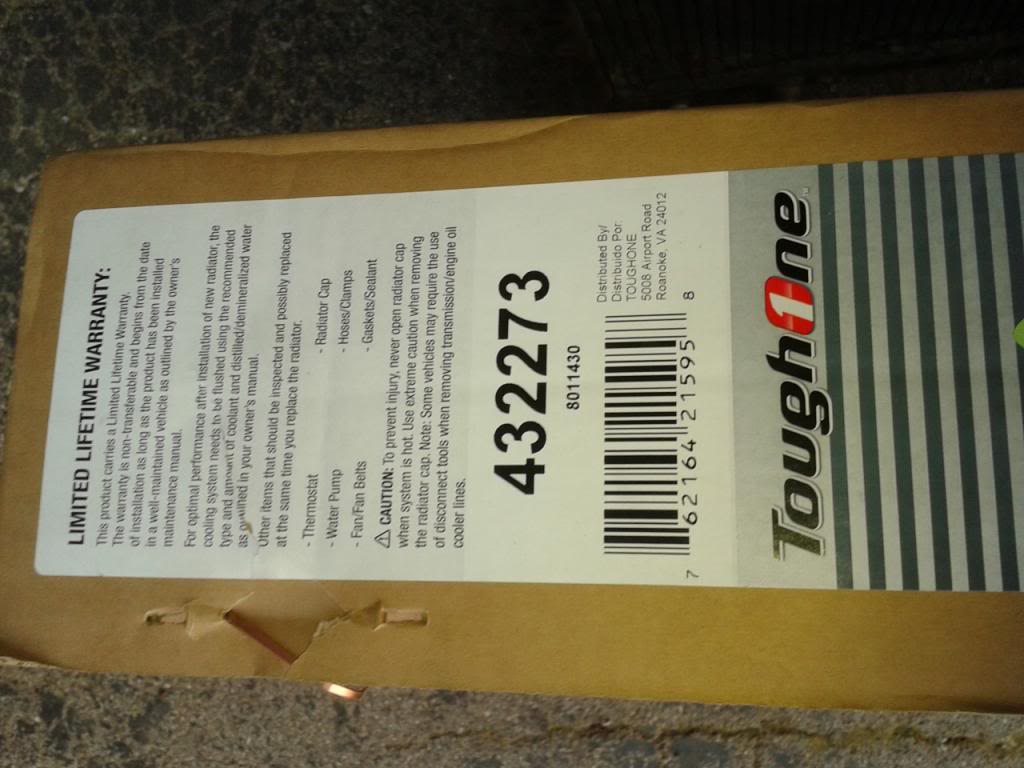
Made in China, but of course.
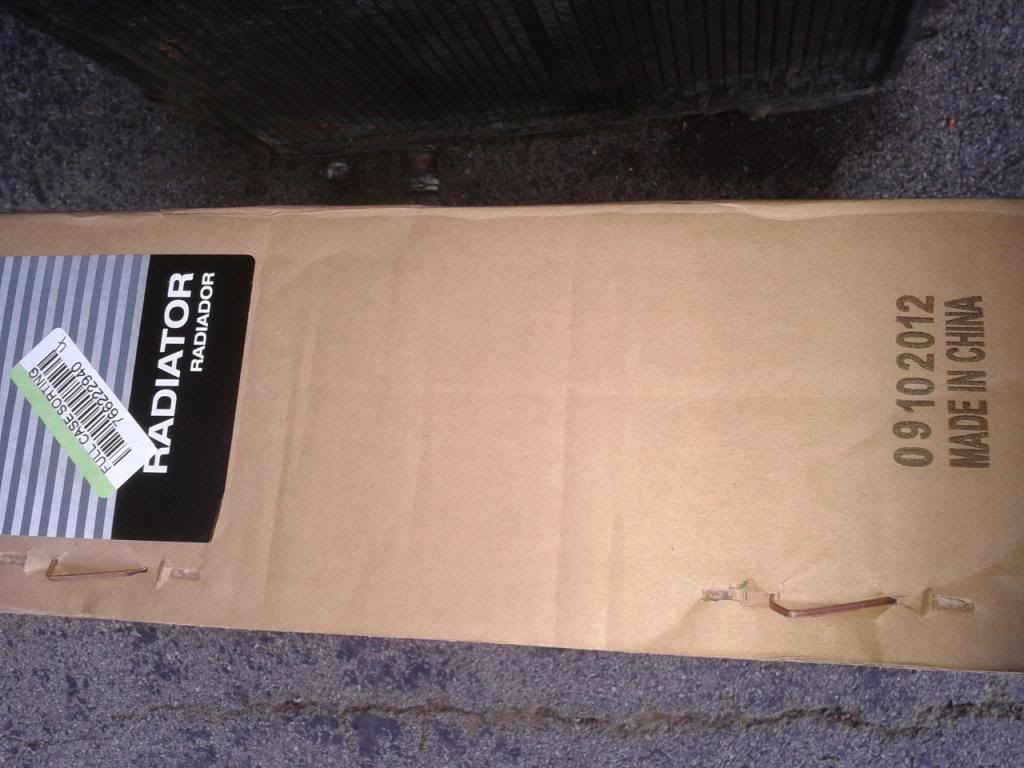
Here's the Stant rad cap that fits it.
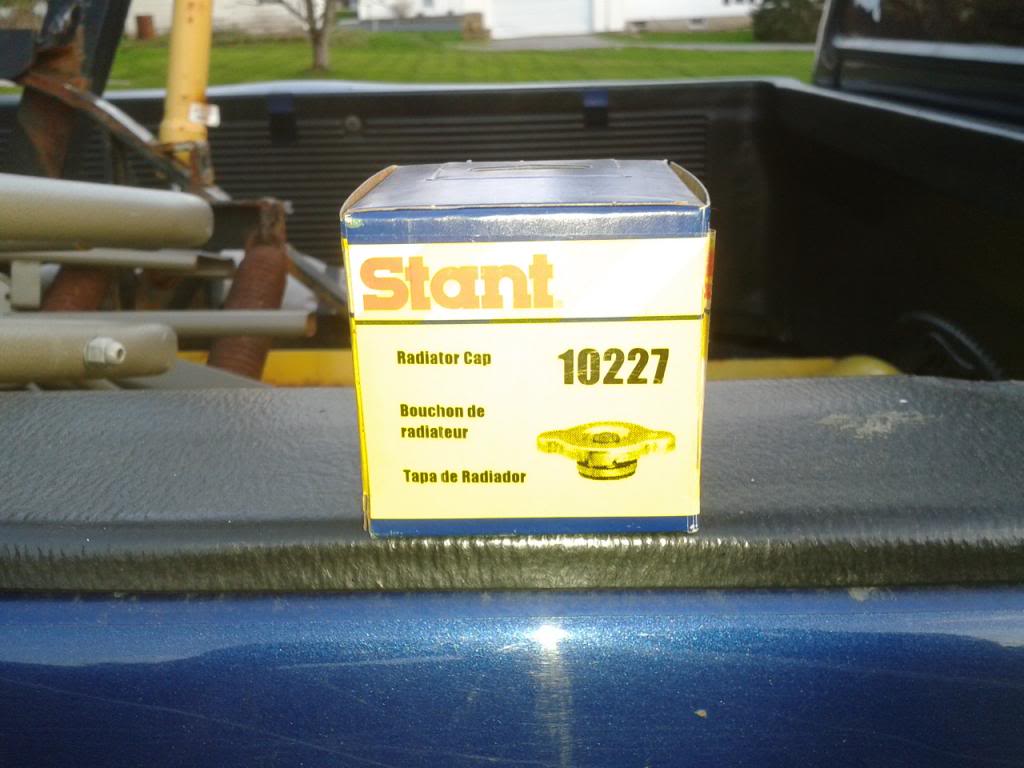
My old rad which is the v6 style next to the new one.
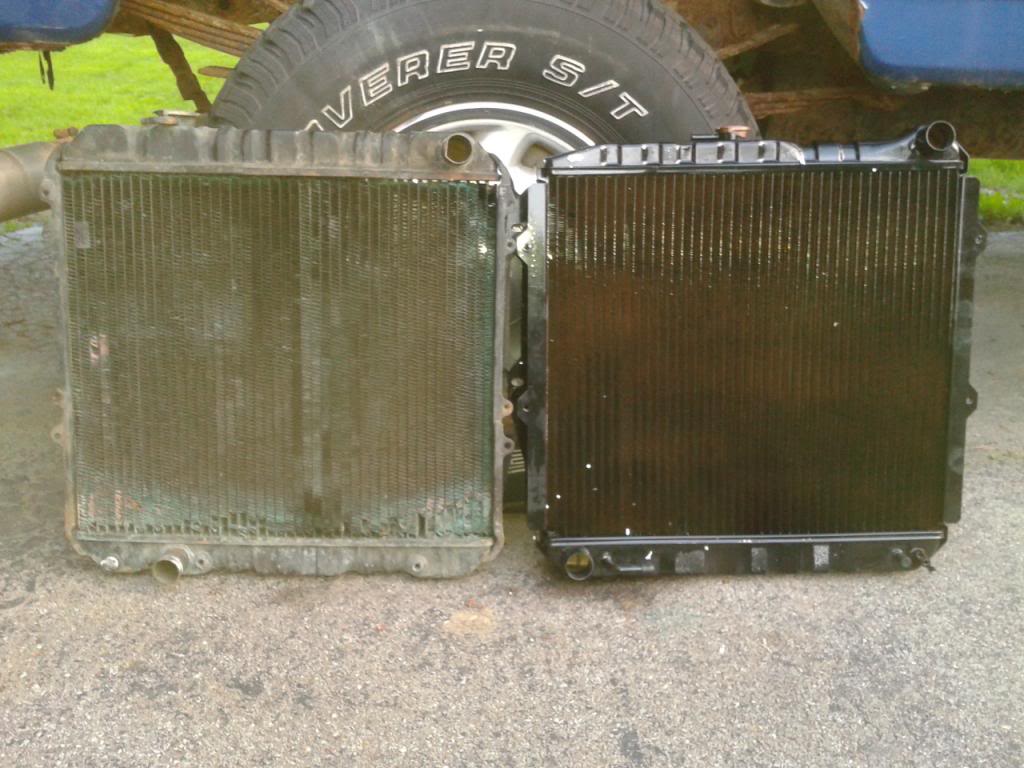
The old one behind the new one. Note how the old top tank is taller than the new one but the new one at the inlet is at same height as old. The position of the mouth is different as well as the overflow vent.
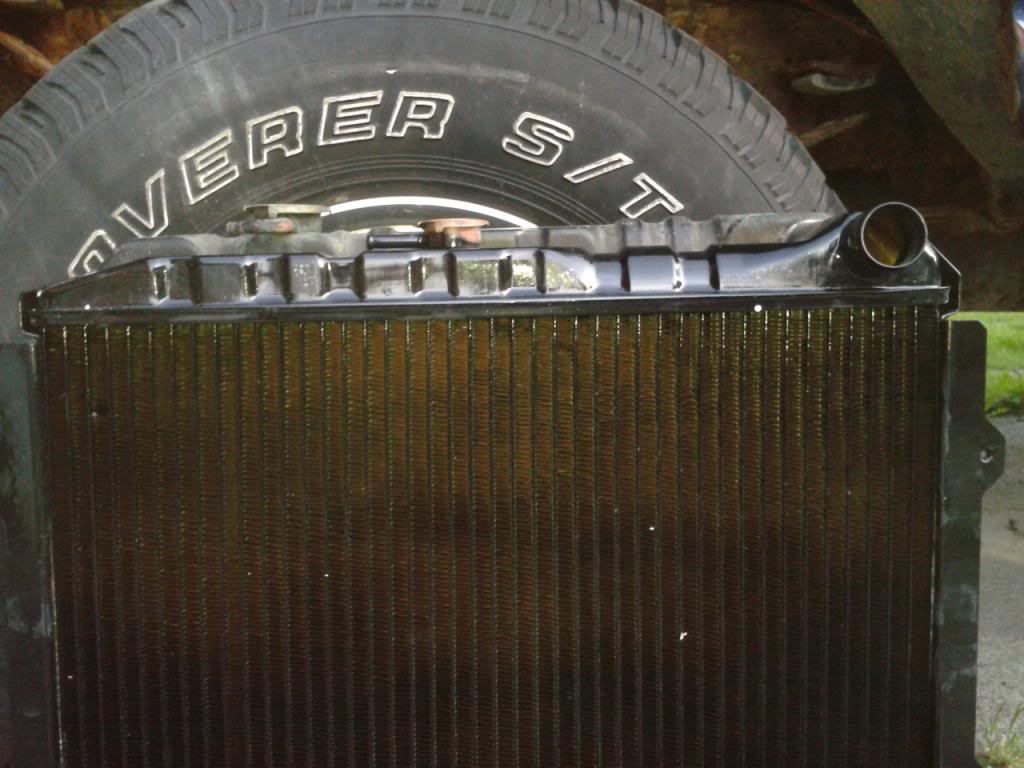
Looking into the old rad - three row with 2" core.
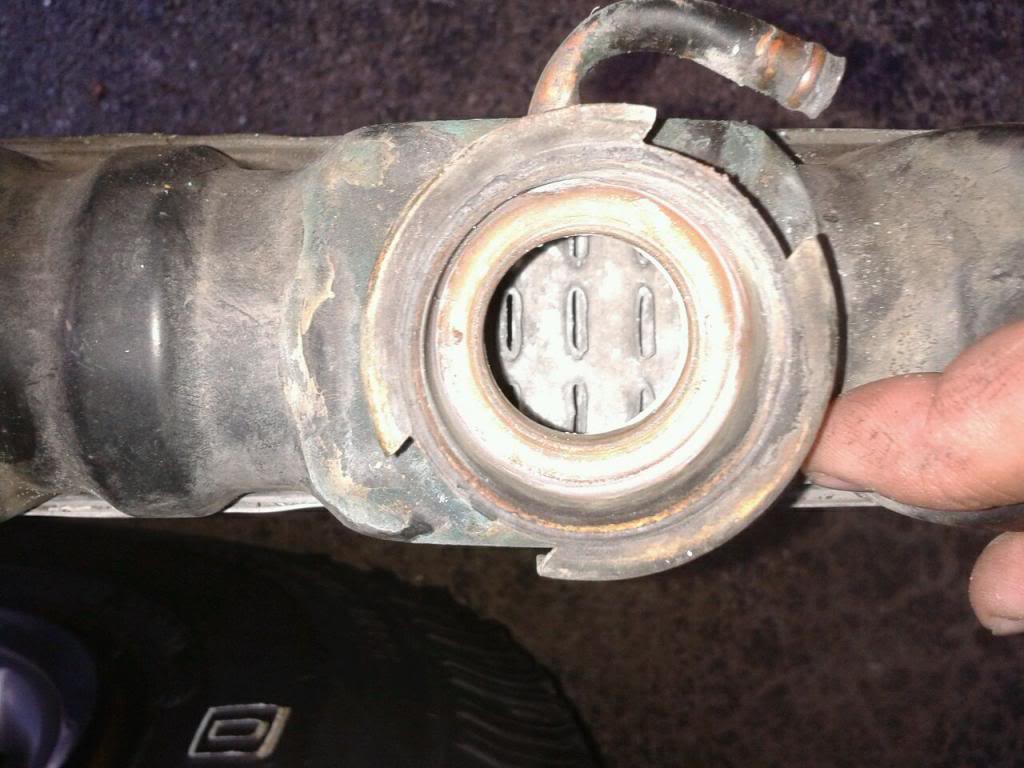
New one has three rows as well.
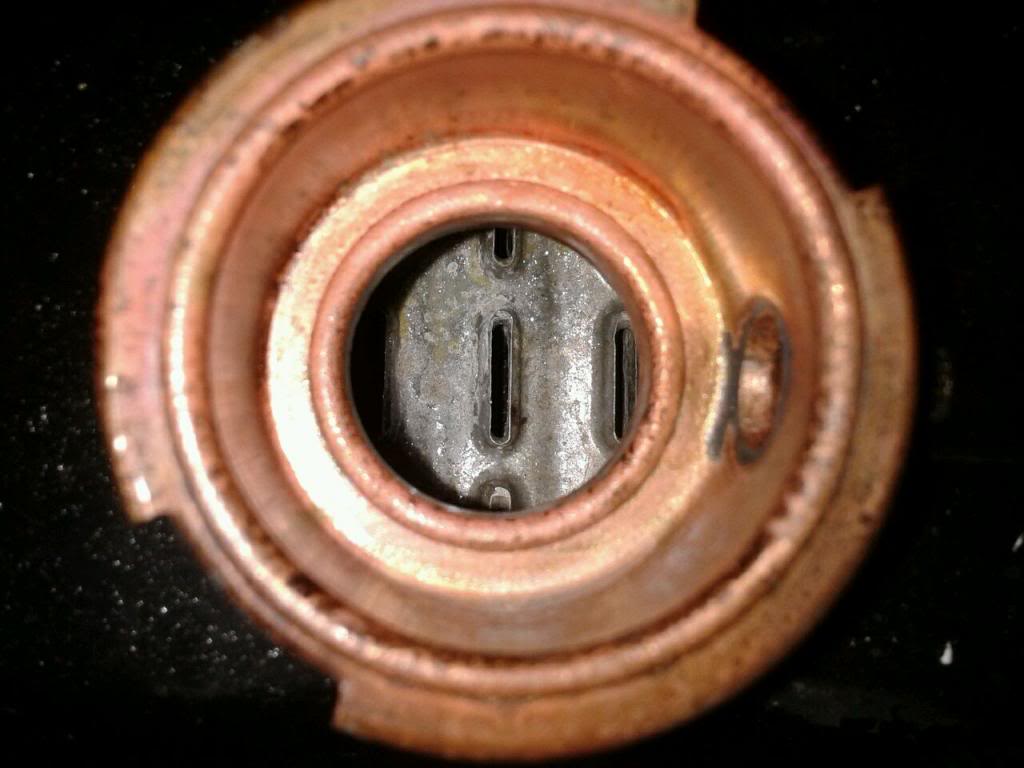
Right side of each. Note that the petcock of new is opposite of old. The mounting bracket widths are a little different as well
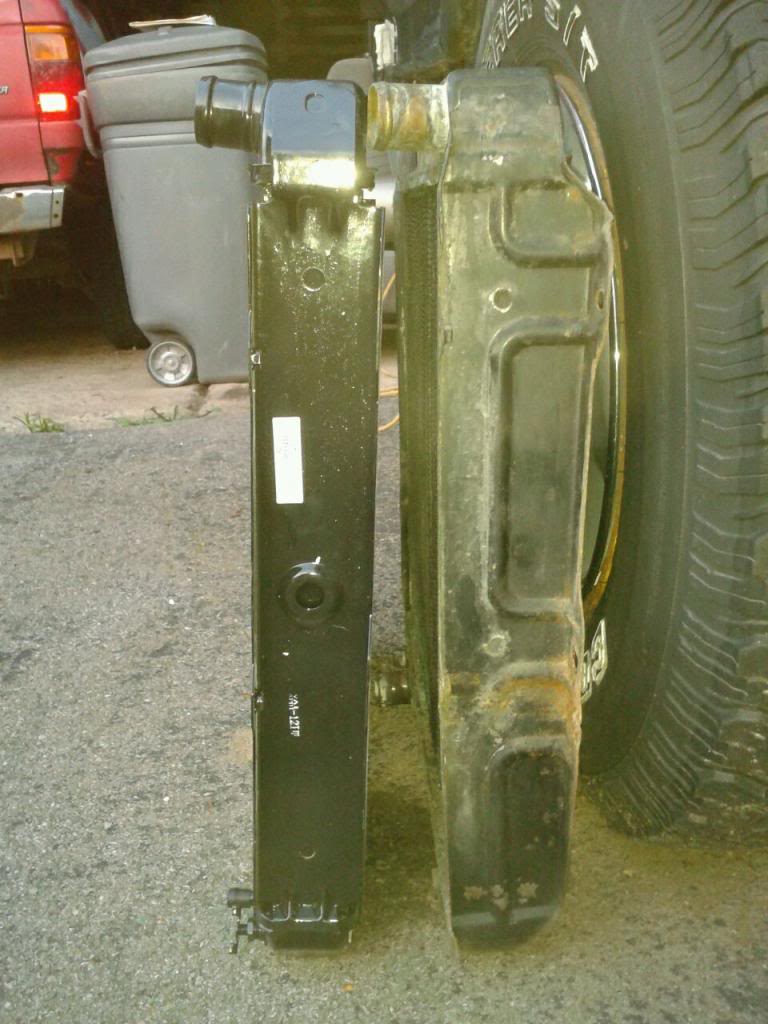
Left side comparison. The new rad bracket has missing mounting taps that are on the old rad. Shouldn't be much of a problem; drill hole and use cable tie. We'll see.
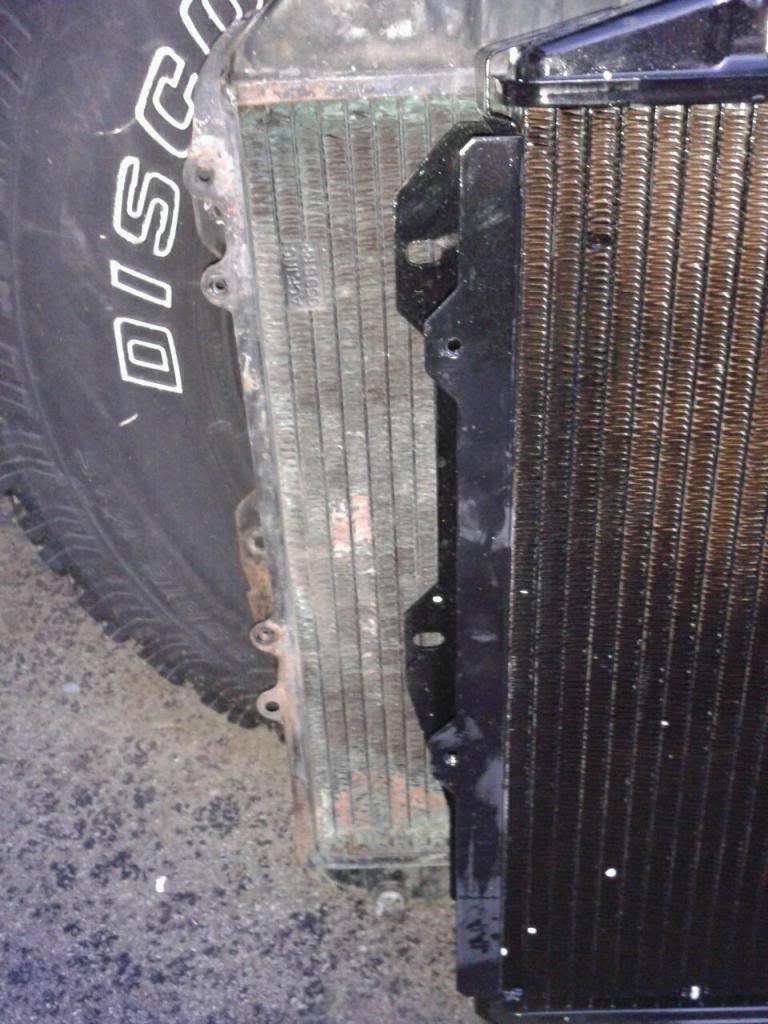
Different angle left shot.
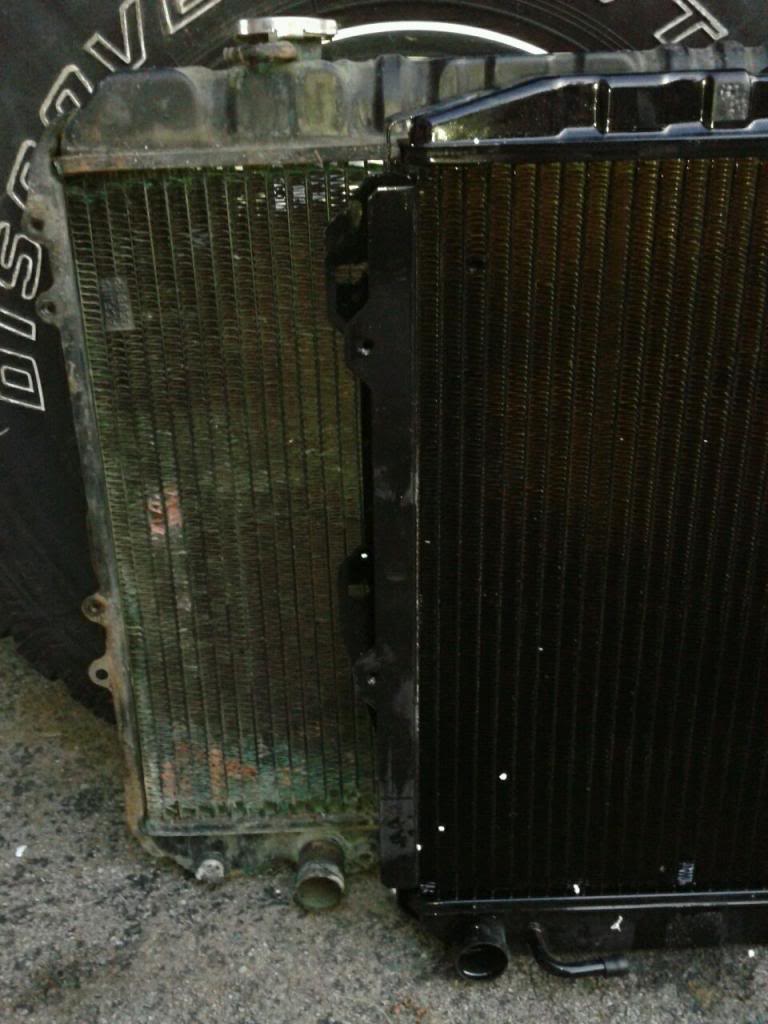
Top shot; old has large rad cap and new has small.
[IMG]http://i1192.photobucket.com/albums
/aa321/daved5150/2013-05-03_201929.jpg[/IMG]
It's a Tough One Radiator part #432273 with Limited Lifetime Radiator.

Made in China, but of course.

Here's the Stant rad cap that fits it.

My old rad which is the v6 style next to the new one.

The old one behind the new one. Note how the old top tank is taller than the new one but the new one at the inlet is at same height as old. The position of the mouth is different as well as the overflow vent.

Looking into the old rad - three row with 2" core.

New one has three rows as well.

Right side of each. Note that the petcock of new is opposite of old. The mounting bracket widths are a little different as well

Left side comparison. The new rad bracket has missing mounting taps that are on the old rad. Shouldn't be much of a problem; drill hole and use cable tie. We'll see.

Different angle left shot.

Top shot; old has large rad cap and new has small.
[IMG]http://i1192.photobucket.com/albums
/aa321/daved5150/2013-05-03_201929.jpg[/IMG]
#37
Registered User
iTrader: (1)
Top shot; old has large rad cap and new has small.
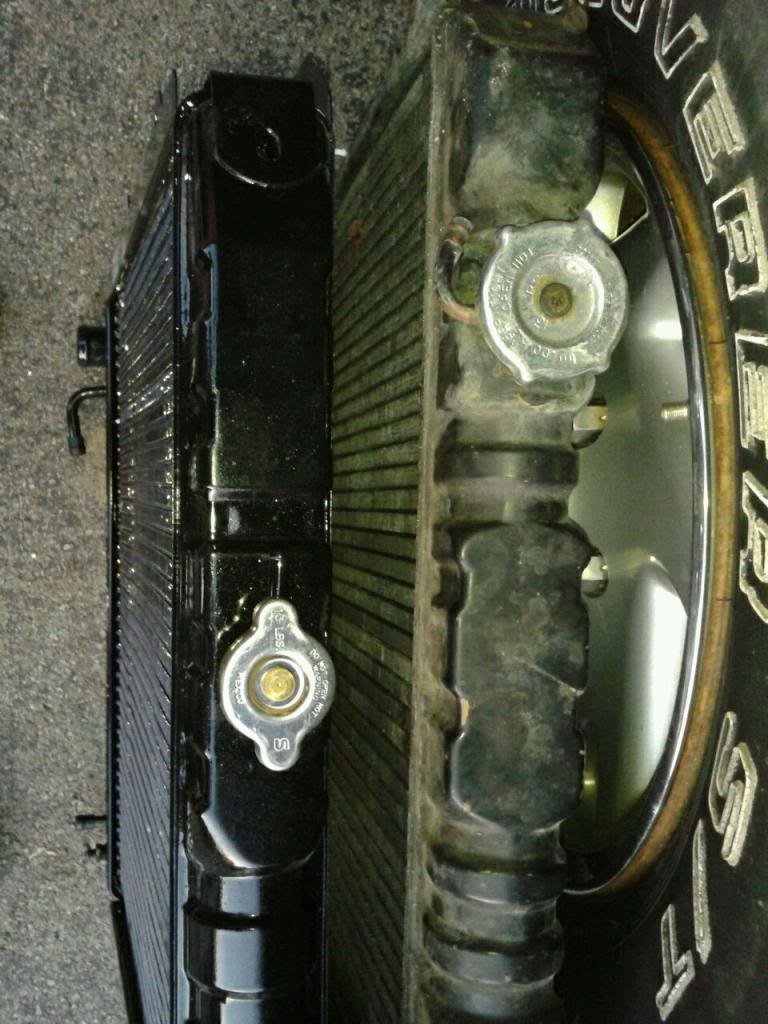
I also have used No-Rosion Cooling System Corrosion Inhibitor which you can get on their site here. I want to try their cooling flush as well once I have the cooling system back together and running.
For more information for anyone that is interested, I checked out these site as well for radiators:
I found Silla all aluminum radiators at this site. Part #7287-2aa is for 4 cylinder and would have been approximately $42 shipped to me here in New York. These are also the rads that were mentioned earlier in this thread about the fact that epoxy is used in them and yes, they are made in China.
There is also ones being sold on Ebay as well.
I also found a two row aluminum rad and a copper/brass rad for the 2.4 on radiatorexpress.com. The guy I talked to said the copper/brass was a CSF which does have the new high efficiency design of two rows with 1 5/8" core. I wanted to go with this one but it was $278 total w shipping which isn't bad, but wanted to save a little money and went with the Advance one.
Performance radiator sells the same one as the above mentioned CSF (I think) product code #1430CBR which is the same size as above. It sells for $221 plus $11 s&h and tax.
Griffin sells a single row with a tube size of 1.5" part#TOY-00052 for $595 but you get what you pay for. But it was a little out of my price range at this time.
I have to leave now. I will finish this later.

I also have used No-Rosion Cooling System Corrosion Inhibitor which you can get on their site here. I want to try their cooling flush as well once I have the cooling system back together and running.
For more information for anyone that is interested, I checked out these site as well for radiators:
I found Silla all aluminum radiators at this site. Part #7287-2aa is for 4 cylinder and would have been approximately $42 shipped to me here in New York. These are also the rads that were mentioned earlier in this thread about the fact that epoxy is used in them and yes, they are made in China.
There is also ones being sold on Ebay as well.
I also found a two row aluminum rad and a copper/brass rad for the 2.4 on radiatorexpress.com. The guy I talked to said the copper/brass was a CSF which does have the new high efficiency design of two rows with 1 5/8" core. I wanted to go with this one but it was $278 total w shipping which isn't bad, but wanted to save a little money and went with the Advance one.
Performance radiator sells the same one as the above mentioned CSF (I think) product code #1430CBR which is the same size as above. It sells for $221 plus $11 s&h and tax.
Griffin sells a single row with a tube size of 1.5" part#TOY-00052 for $595 but you get what you pay for. But it was a little out of my price range at this time.
I have to leave now. I will finish this later.
#38
Registered User
iTrader: (1)
This article about aluminum versus copper is from this site. There is a fair amount of cooling system information on this site. Here is the article which is interesting to say the least:
What makes the better radiator;
Aluminum or Copper?
I get asked this question so often that I feel like a broken record telling the pros & cons over and over. I am not a scientist, chemist or engineer but based on my 28 years in the radiator business here is my opinion on which is better; copper or aluminum radiators.
There is much debate over whether a copper or an aluminum radiator will cool better. There are pros and cons to each material. It has been scientifically proven that copper actually transfers heat better than aluminum. It is easier to repair in most cases than aluminum and until the last couple of years was much less expensive. The drawbacks to a copper radiator are the weight difference (aluminum is much lighter) and the solder joints that hold it together. The solder that secures the tubes to the fins does not transfer heat as quickly as copper and slows down the heat transfer. The presence of solder where the tubes are soldered into the headers is also the main cause of what is known as “solder bloom”. I am sure all of you have looked inside a radiator at some time and observed the white residue growing around the tubes. This growth is the result of chemical reactions from different metals (brass tubes, copper header, lead/tin solder) and lime and other chemicals in the water/antifreeze mixture. In the 1990’s some manufacturers started using a process called “Copubraze” which eliminated the solder between the tubes and the headers. The tubes were brazed instead of soldered which prevented the solder bloom problem and also created a better made core. This process was more costly however and most manufacturers were favoring aluminum anyway due to the weight savings. Copper core manufacturers also started using smaller and thinner tubes to break the coolant down into smaller amounts to further improve cooling. Smaller tubes clogged up much easier especially when the vehicles owner did not adhere to recommended cooling system flushing intervals. They also used thinner material to cut weight and improve heat transfer but the longevity suffered.
Aluminum radiators are welded or “aluminum brazed” and the finished piece is 100% aluminum. This eliminates the dissimilar metals and solder bloom problems that affect copper radiators. Aluminum radiators can also use wider tubes that create more surface contact area from the tubes to the fins and helps dissipate the heat quicker. Most aluminum radiators use 1” wide tubes and some manufacturers like Griffin offer 1.25” and 1.5” tubes as well. Traditional copper radiators usually use ˝” tubes so a 4 row copper radiator has slightly less fin contact area than a 2 row aluminum core with 1” tubes when you take into account the loss of contact area at the curved ends of the tubes. Most OEM copper radiators were built with the tubes on 9/16” centers from each other. All aluminum cores are built with the tubes on 7/16” or 3/8” centers creating a denser and more efficient core than a standard copper core. I generally tell customers that a high efficiency (tubes on 7/16” or closer centers) copper four row will cool the same as an aluminum core with two rows of 1” tubes. If more cooling is required from the radiator than either of these designs will provide, than an aluminum core with two rows of 1.25” is the thickest recommended for a street application. Any thicker than that and you may have trouble pulling air through the core at low speeds or when at a light.
Aluminum offers the advantage of about 30% to 40% less weight. To a racer this is a huge advantage over copper. Aluminum can also be polished out to a mirror like finish for those concerned with show appearance. Neither has an advantage when it comes to corrosion. Left unprotected, a copper radiator core will turn green and deteriorate rapidly especially in a damp environment. That is why copper radiators have always been painted, usually black. Aluminum will oxidize if not protected from the elements.
If your radiator needs to be replaced and you want to retain as much originality as possible then recoring your original copper radiator may be the best choice for you. A copper radiator core can be made more efficient by changing the tube spacing and fin count. As I stated earlier the radiators that were made from the 1950’s to the 1970’s generally used ˝” wide tubes placed on 9/16” centers from each other. If you counted the fins you might get as few as 6 or 8 fins per inch (FPI). If the tubes are placed closer together and the fins are packed in tighter a denser core is created that throws off much more heat. A high efficiency core can have tubes on 7/16”, 3/8” or even 5/16” centers and fin counts increased to 12 to 14 FPI. That may not seem like a big deal but the surface area is greatly increased. As an example; a 26” wide radiator core with tubes on 9/16” centers has about 45 tubes from side to side. A high efficiency core of the same width has 57 tubes from side to side. Combined with all the additional fins between the tubes this provides approximately 25% to 30% better cooling than the OEM radiator had. A three row high efficiency core will cool about the same as a regular four row without taking away another 5/8” of fan clearance. Going to a thicker core will cool better but there is one big thing to remember. As the air passes through each row of tubes it is picking up heat along the way. The air cools off each following row of tubes a little less than the previous rows. A four row core is of course better than a two row core but increasing a cores thickness does not necessarily mean it will continue to get more efficient as it gets thicker. As I said earlier a core that is too thick will also impede the airflow at low speeds.
So which is better, aluminum or copper? My opinion is neither. Each one has advantages over the other in different areas. The decision over which to use in your particular case comes down to what is more important to you. Weight, appearance, originality and cost all need to be considered before you make your decision. From my own experience on my own vehicles I have found that a properly built high efficiency copper radiator will cool the same as a well made aluminum radiator. Like I said at the beginning, I am not a scientist or an engineer but this is my opinion and I’m stickin’ to it.
Cap-A-Radiator
What makes the better radiator;
Aluminum or Copper?
I get asked this question so often that I feel like a broken record telling the pros & cons over and over. I am not a scientist, chemist or engineer but based on my 28 years in the radiator business here is my opinion on which is better; copper or aluminum radiators.
There is much debate over whether a copper or an aluminum radiator will cool better. There are pros and cons to each material. It has been scientifically proven that copper actually transfers heat better than aluminum. It is easier to repair in most cases than aluminum and until the last couple of years was much less expensive. The drawbacks to a copper radiator are the weight difference (aluminum is much lighter) and the solder joints that hold it together. The solder that secures the tubes to the fins does not transfer heat as quickly as copper and slows down the heat transfer. The presence of solder where the tubes are soldered into the headers is also the main cause of what is known as “solder bloom”. I am sure all of you have looked inside a radiator at some time and observed the white residue growing around the tubes. This growth is the result of chemical reactions from different metals (brass tubes, copper header, lead/tin solder) and lime and other chemicals in the water/antifreeze mixture. In the 1990’s some manufacturers started using a process called “Copubraze” which eliminated the solder between the tubes and the headers. The tubes were brazed instead of soldered which prevented the solder bloom problem and also created a better made core. This process was more costly however and most manufacturers were favoring aluminum anyway due to the weight savings. Copper core manufacturers also started using smaller and thinner tubes to break the coolant down into smaller amounts to further improve cooling. Smaller tubes clogged up much easier especially when the vehicles owner did not adhere to recommended cooling system flushing intervals. They also used thinner material to cut weight and improve heat transfer but the longevity suffered.
Aluminum radiators are welded or “aluminum brazed” and the finished piece is 100% aluminum. This eliminates the dissimilar metals and solder bloom problems that affect copper radiators. Aluminum radiators can also use wider tubes that create more surface contact area from the tubes to the fins and helps dissipate the heat quicker. Most aluminum radiators use 1” wide tubes and some manufacturers like Griffin offer 1.25” and 1.5” tubes as well. Traditional copper radiators usually use ˝” tubes so a 4 row copper radiator has slightly less fin contact area than a 2 row aluminum core with 1” tubes when you take into account the loss of contact area at the curved ends of the tubes. Most OEM copper radiators were built with the tubes on 9/16” centers from each other. All aluminum cores are built with the tubes on 7/16” or 3/8” centers creating a denser and more efficient core than a standard copper core. I generally tell customers that a high efficiency (tubes on 7/16” or closer centers) copper four row will cool the same as an aluminum core with two rows of 1” tubes. If more cooling is required from the radiator than either of these designs will provide, than an aluminum core with two rows of 1.25” is the thickest recommended for a street application. Any thicker than that and you may have trouble pulling air through the core at low speeds or when at a light.
Aluminum offers the advantage of about 30% to 40% less weight. To a racer this is a huge advantage over copper. Aluminum can also be polished out to a mirror like finish for those concerned with show appearance. Neither has an advantage when it comes to corrosion. Left unprotected, a copper radiator core will turn green and deteriorate rapidly especially in a damp environment. That is why copper radiators have always been painted, usually black. Aluminum will oxidize if not protected from the elements.
If your radiator needs to be replaced and you want to retain as much originality as possible then recoring your original copper radiator may be the best choice for you. A copper radiator core can be made more efficient by changing the tube spacing and fin count. As I stated earlier the radiators that were made from the 1950’s to the 1970’s generally used ˝” wide tubes placed on 9/16” centers from each other. If you counted the fins you might get as few as 6 or 8 fins per inch (FPI). If the tubes are placed closer together and the fins are packed in tighter a denser core is created that throws off much more heat. A high efficiency core can have tubes on 7/16”, 3/8” or even 5/16” centers and fin counts increased to 12 to 14 FPI. That may not seem like a big deal but the surface area is greatly increased. As an example; a 26” wide radiator core with tubes on 9/16” centers has about 45 tubes from side to side. A high efficiency core of the same width has 57 tubes from side to side. Combined with all the additional fins between the tubes this provides approximately 25% to 30% better cooling than the OEM radiator had. A three row high efficiency core will cool about the same as a regular four row without taking away another 5/8” of fan clearance. Going to a thicker core will cool better but there is one big thing to remember. As the air passes through each row of tubes it is picking up heat along the way. The air cools off each following row of tubes a little less than the previous rows. A four row core is of course better than a two row core but increasing a cores thickness does not necessarily mean it will continue to get more efficient as it gets thicker. As I said earlier a core that is too thick will also impede the airflow at low speeds.
So which is better, aluminum or copper? My opinion is neither. Each one has advantages over the other in different areas. The decision over which to use in your particular case comes down to what is more important to you. Weight, appearance, originality and cost all need to be considered before you make your decision. From my own experience on my own vehicles I have found that a properly built high efficiency copper radiator will cool the same as a well made aluminum radiator. Like I said at the beginning, I am not a scientist or an engineer but this is my opinion and I’m stickin’ to it.
Cap-A-Radiator
#39
Registered User
Join Date: May 2010
Location: Truckee, CA
Posts: 38
Likes: 0
Received 0 Likes
on
0 Posts
Re. Toyota aftermarket radiators
Great info here, especially this last post from radiator expert man, so I'll resurrect this thread again. It's been a couple of years since all this was posted. Any news on what's endured and what's failed? Or otherwise?
I'm needing to replace the '84's radiator and keep the Flex-a-lite electric fan, which is a direct replacement fan that fit on the fan shroud mounting holes. I am actually thinking about the 3-row OEM unit again.
I'm needing to replace the '84's radiator and keep the Flex-a-lite electric fan, which is a direct replacement fan that fit on the fan shroud mounting holes. I am actually thinking about the 3-row OEM unit again.
#40
Registered User
iTrader: (1)
Join Date: Mar 2014
Location: Phoenix...land of the "A/C REQUIRED"
Posts: 35
Likes: 0
Received 0 Likes
on
0 Posts
Best Radiator For EXTREME Heat??
I'd like to also resurrect this thread. 
The above post is amazing info!!
I was all ready to buy an all aluminum rad, but now I'm having second thoughts. Seems the best option is to take my current radiator (I's an aftermarket for a V6) and just have it re-cored at Performance Radiator with a higher density core.
Anyone have any feedback/experience on the best 'extreme' heat rad?
I'm in AZ and will be crawling in VERY hot desert with A/C running. Need all the heat elimination I can get.
Thanks!

The above post is amazing info!!
I was all ready to buy an all aluminum rad, but now I'm having second thoughts. Seems the best option is to take my current radiator (I's an aftermarket for a V6) and just have it re-cored at Performance Radiator with a higher density core.
Anyone have any feedback/experience on the best 'extreme' heat rad?
I'm in AZ and will be crawling in VERY hot desert with A/C running. Need all the heat elimination I can get.
Thanks!


 you lucky devil you !!
you lucky devil you !!






